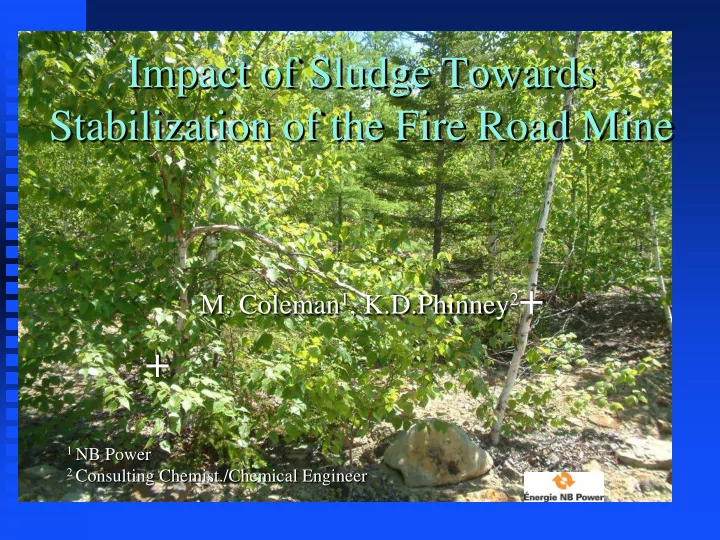

Impact of Sludge Towards Stabilization of the Fire Road Mine M. Coleman 1 , K.D.Phinney 2 + + 1 NB Power 2 Consulting Chemist./Chemical Engineer
Mine Location
Background Mined 1982-1985; 250 acre site (100 ha). AMD since mid-80’s. Waste rock contoured Hydrated lime treatment 4 one -acre sludge ponds/yr Long term solution-sludge disposal into waste rock
Initial Dredging Rationale Disposing of lime neutralization sludge into acid generating rock could provide several benefits including: utilization of the excess alkalinity final disposal area for sludge minimize additional land disturbance decrease personal liability reduce accessibility of oxygen into the waste rock.
Equivalent Lime Consumption and Mine Water Pond Acidity 3500 3000 CaCO3 equiv of lime consumed Mg/L as CaCO3 Tonnes of CaCO3 2500 Mine water pond Acidity 2000 (mg/L) 1500 1000 500 0 1992 1994 1996 1998 2000 2002 2004 2006 2008 2010 2012 2014 2016 Years
Decreasing Acidity in Mine Water from Monitoring Wells Acidity Scale (mg/l) Pink >1000 Orange 200-1000 Gray 150-200 Green <150
Factors That May be Impacting the Change in Acid Generation 1. Waste rock weathering. 2. Vegetation coverage increasing. 3. Putting the sludge back onto the waste rock. 4. pH of precipitation • 26,000 m 3 sludge, late fall 2014
Objectives We are noticing a decrease in mine water acidity. Why? Changes in in-situ neutralization? Impact of neutral pH groundwater or precip recharge? Waste rock weathering into smaller particles? Is AMD burning out? Can you measure or calculate the impact of the sludge on the acidity of the mine water? Are there short term impacts that can be identified after each dredging period?
Groundwater Chemistry Evaluation Generated acidity (initial acidity) Calculated acidity as a result of oxidation of sulfide minerals Equivalent to SO 4 -2 concentration (original H 2 SO 4 ) Residual acidity Calculated acidity due to mineral acidity (H + ) and conc. of metallic ions (Al, Fe, Mn, Cu and Zn) Equivalent to CaCO 3 demand for neutralization % Acidity removed in-situ in the waste rock Difference between (initial and residual)/initial)
versus Compare Consumed CaCO 3 Calculated Residual Acidity Demand Equivalent to CaCO 3 demand for neutralization
Comparison of Calculated Residual Acidity versus Measured Acidity 200 180 160 Mg/L as CaCO3 140 120 100 80 Residual Acidity 60 40 Acidity Measured in Grab 20 Sample 0 Apr-14 Jun-14 Aug-14 Oct-14 Dec-14 Feb-15 Apr-15 Jun-15 Aug-15 Oct-15 Dec-15 Feb-16 Apr-16 Jun-16 Aug-16 Oct-16 Dec-16
Groundwater Monitoring
Initial and Residual Acidity in Mine Water Well 26S, 26D and 27 8000 100 mg/L as CaCO3 MW 26S % Reacted 80 6000 60 4000 40 2000 20 0 0 1988 1996 2006 2014 5000 100 MW26D 4000 80 3000 60 2000 40 1000 20 0 0 1988 1996 2006 2014
Initial and Residual Acidity in Mine Water Wells 17S, 17D and 16D 8000 100 MW 17S 1800 100 MW16D 80 6000 1600 60 4000 80 1400 40 2000 20 1200 0 0 60 1000 1988 1996 2006 2014 10000 100 800 MW17D 40 MW 17D % acid removed 8000 80 Initial Generated Acidity (mg/l) 600 residual acidty (mg/l) 6000 60 400 20 4000 40 200 2000 20 0 0 0 0 1988 1998 Jun-10 1988 1996 2006 Jun-14
Acidity in Mine Water Pond Comparison of Initial and Residual Acidity (mg/L as CaCO3) 1000 1200 1400 1600 1800 2000 200 400 600 800 0 Jun-96 Jun-97 Jun-98 Jun-99 Jun-00 Jun-01 Jun-02 Jun-03 Jun-04 Jun-05 Year Jun-06 Jun-07 Jun-08 Jun-09 Jun-10 Jun-11 Pond Residual Acidity Initial Acidity Pond Jun-12 Jun-13 Jun-14 Jun-15 Jun-16
Comparison of Initial and Residual Acidity in Mine Water Pond- Impact of Dredging 1200 Initial Acidity Pond Residual Acidity Pond 1000 mg/L as CaCO3 800 600 400 200 0 Jun-10 Jun-11 Jun-12 Jun-13 Jun-14 Jun-15 Jun-16 Years
Mine Water Pond -% Acidity Removed In-situ 100 Percent Acidity Removed In-situ 90 80 70 60 50 40 30 20 10 0 Apr-10 Aug-10 Dec-10 Apr-11 Aug-11 Dec-11 Apr-12 Aug-12 Dec-12 Apr-13 Aug-13 Dec-13 Apr-14 Aug-14 Dec-14 Apr-15 Aug-15 Dec-15 Apr-16 Aug-16 Dec-16 Year
Estimated Lime Savings after Dredging 300 25.0 Ave Residual Acidity Prior to Lime Savings (thousands of dollars) Dredging Ave Residual Acidity After 250 Dredging 20.2 20.0 Lime Savings at Ca(OH)2 tonnes of Ca(OH)2 (tonnes) Acidity (mg/L) Lime Savings ($) 200 15.0 13.5 150 11.6 10.0 100 6.4 54 5.0 4.5 39 50 35 3.4 20 12 9 0 0.0 2010 2012 2014 2015 2016 2017 Year of Dredging
Conclusions Decreases in initial mine water acidity a result of acid generation “burning out”-less acid production. SO 4 decreasing , (example well 26 above the sludge influence) mine water pH increasing lower Al conc so partial dissolution of feldspars and mica? In-situ neutralization is occurring. Residual acidity is much less than initial acidity We saw in well 16D that we can have initial acidity but have it mostly neutralized in-situ.
Conclusions The percentage of acidity removed in-situ is increasing. Waste rock weathering (smaller particle size… increased surface area)? Trend will most likely continue but those sites at higher percentages seem to taper off and not hit 100% Based at what we saw at well 16D, we may not need to hit 100%. At what point will the residual acidity be negligible at the mine water pond but “spot” neutralization may be required at specific areas within the mine site? Look at surface amendments to increase alkalinity?
Conclusions There are some measurements that can be made on the impact of the sludge on the acidity of the mine water. The effect of dredging can be monitored by acidity and pH changes as a plug or plume flow in the mine water pond chemistry. Almost $60K in estimated lime savings from last 4 dredging episodes Propose to look at potential cost savings to recycle sludge directly back into waste rock during low groundwater flow periods to reduce dredging costs.
Impact of Sludge Towards Stabilization of the Fire Road Mine In memory of K.D.Phinney 2 1946-February 2017 1 NB Power 2 Consulting Chemist./Chemical Engineer
Recommend
More recommend